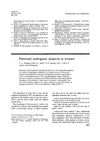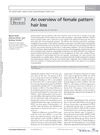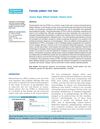Female Pattern Baldness in Men
November 1993
in “
Journal of The American Academy of Dermatology
”
female pattern androgenetic alopecia baldness of the crown frontal hairline male pattern baldness Hamilton's classification telogen hairs trichogram scalp biopsy miniaturized hair follicles androgenetic alopecia diffuse hair loss circulating androgens diffuse telogen effluvium female pattern baldness crown baldness frontal hairline preservation male pattern baldness Hamilton's classification telogen hairs hair analysis scalp biopsy miniaturized hair follicles androgenetic alopecia diffuse hair loss high androgen levels diffuse telogen effluvium

TLDR Some men can have female pattern baldness without hormonal abnormalities or signs of feminization.
The document describes a study of two men, aged 39 and 28, who exhibited female pattern androgenetic alopecia, characterized by baldness of the crown while preserving the frontal hairline. This pattern is in contrast to the typical male pattern baldness, which includes a receding hairline at the temples and vertex balding. The study aimed to highlight that while Hamilton's classification of male pattern baldness is widely used, it does not account for the occurrence of female pattern baldness in men. Both subjects had a family history of typical male pattern baldness and showed no signs of feminization or hormonal abnormalities. A trichogram revealed an increased number of telogen hairs in the frontal region for both patients, and a scalp biopsy from the first patient showed miniaturized hair follicles, which are characteristic of androgenetic alopecia. The study suggests that female pattern baldness in men may progress more rapidly to complete baldness due to higher levels of circulating androgens in men, and it can be confused with other causes of diffuse hair loss. The findings support the diagnosis of androgenetic alopecia rather than diffuse telogen effluvium from other causes.








